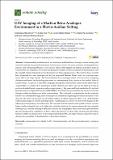Por favor, use este identificador para citar o enlazar a este item:
http://hdl.handle.net/10261/206001COMPARTIR / EXPORTAR:
 SHARE SHARE
 CORE
BASE CORE
BASE
|
|
| Visualizar otros formatos: MARC | Dublin Core | RDF | ORE | MODS | METS | DIDL | DATACITE | |

| Título: | UAV imaging of a martian brine analogue environment in a fluvio-aeolian setting |
Autor: | Bhardwaj, Anshuman; Sam, Lydia; Martín-Torres, F. J.; Zorzano, María Paz CSIC ORCID ; Ramírez Luque, Juan Antonio | Palabras clave: | Unmanned Aerial Vehicle (UAV) Photogrammetry Salt flat Geomorphometry Analogue research |
Fecha de publicación: | 9-sep-2019 | Editor: | Multidisciplinary Digital Publishing Institute | Citación: | Remote Sensing 11 (18): 2104 (2019) | Resumen: | Understanding extraterrestrial environments and landforms through remote sensing and terrestrial analogy has gained momentum in recent years due to advances in remote sensing platforms, sensors, and computing efficiency. The seasonal brines of the largest salt plateau on Earth in Salar de Uyuni (Bolivian Altiplano) have been inadequately studied for their localized hydrodynamics and the regolith volume transport across the freshwater-brine mixing zones. These brines have recently been projected as a new analogue site for the proposed Martian brines, such as recurring slope lineae (RSL) and slope streaks. The Martian brines have been postulated to be the result of ongoing deliquescence-based salt-hydrology processes on contemporary Mars, similar to the studied Salar de Uyuni brines. As part of a field-site campaign during the cold and dry season in the latter half of August 2017, we deployed an unmanned aerial vehicle (UAV) at two sites of the Salar de Uyuni to perform detailed terrain mapping and geomorphometry. We generated high-resolution (2 cm/pixel) photogrammetric digital elevation models (DEMs) for observing and quantifying short-term terrain changes within the brines and their surroundings. The achieved co-registration for the temporal DEMs was considerably high, from which precise inferences regarding the terrain dynamics were derived. The observed average rate of bottom surface elevation change for brines was ~1.02 mm/day, with localized signs of erosion and deposition. Additionally, we observed short-term changes in the adjacent geomorphology and salt cracks. We conclude that the transferred regolith volume via such brines can be extremely low, well within the resolution limits of the remote sensors that are currently orbiting Mars, thereby making it difficult to resolve the topographic relief and terrain perturbations that are produced by such flows on Mars. Thus, the absence of observable erosion and deposition features within or around most of the proposed Martian RSL and slope streaks cannot be used to dismiss the possibility of fluidized flow within these features. | Versión del editor: | http://dx.doi.org/10.3390/rs11182104 | URI: | http://hdl.handle.net/10261/206001 | DOI: | 10.3390/rs11182104 | Identificadores: | doi: 10.3390/rs11182104 issn: 2072-4292 |
| Aparece en las colecciones: | (IACT) Artículos (CAB) Artículos |
Ficheros en este ítem:
| Fichero | Descripción | Tamaño | Formato | |
|---|---|---|---|---|
| Remote Sensing 11 2104.pdf | 6,93 MB | Adobe PDF |  Visualizar/Abrir |
CORE Recommender
SCOPUSTM
Citations
6
checked on 18-abr-2024
WEB OF SCIENCETM
Citations
4
checked on 26-feb-2024
Page view(s)
194
checked on 23-abr-2024
Download(s)
217
checked on 23-abr-2024
Google ScholarTM
Check
Altmetric
Altmetric
Este item está licenciado bajo una Licencia Creative Commons

